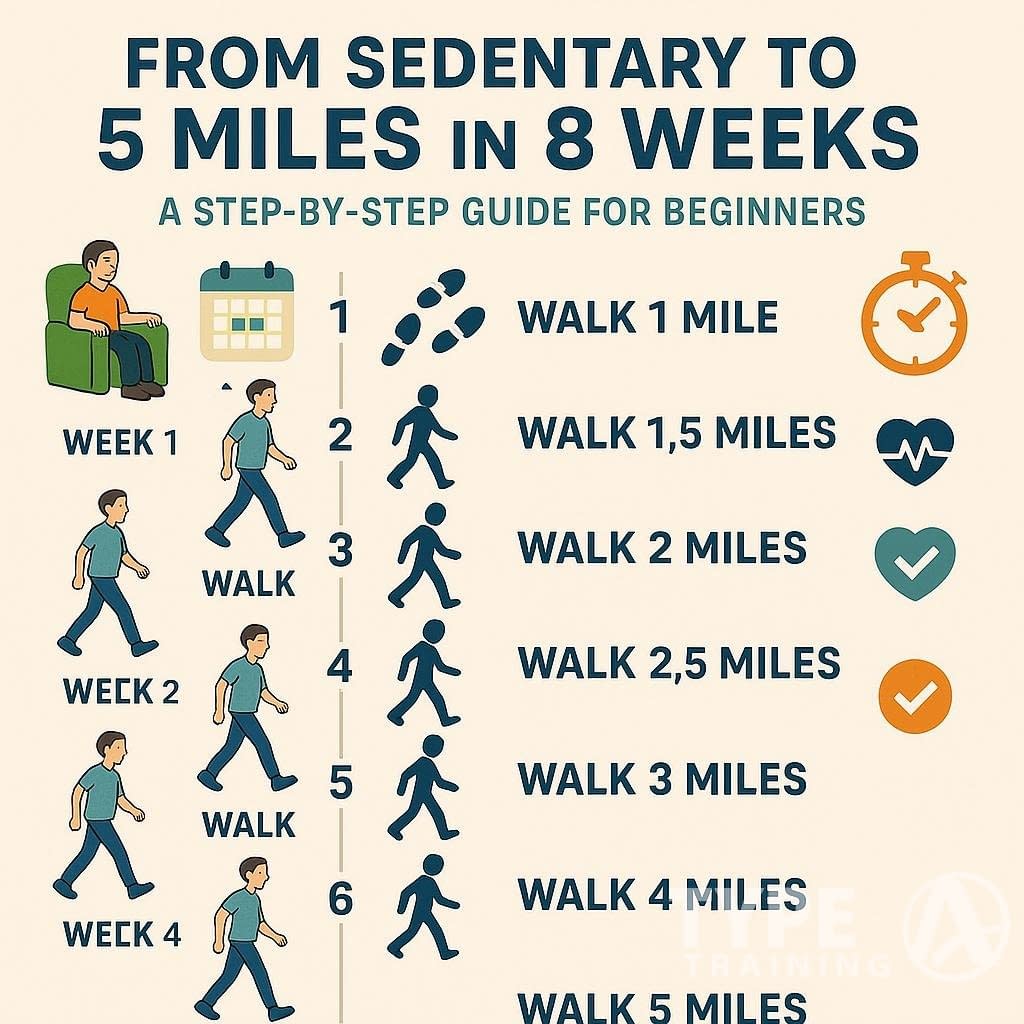Walking might just be the easiest way to shift from a sedentary lifestyle to a more active one. No fancy gear or athletic background required—just a pair of comfortable
A progressive walking plan can genuinely change your fitness in 8 weeks, moving you from short 10-15 minute strolls to confidently walking 5 miles a day.

Start with short, 15-minute walks three times a week. Gradually work up to 40 minutes, five times a week, and you’ll see real, lasting changes.
Popular posts:
This slow build helps your body adapt, keeps injuries at bay, and boosts your heart health and stamina. The 8-week walking program makes it easier to ease into regular physical activity without overdoing it.
Research actually shows that walking can reduce both subcutaneous and visceral belly fat. Noticeable results often show up in just 2-4 weeks if you stick to a plan.
Aiming for 5 miles a day (about 10,000 steps) is a solid target for health benefits. By ramping up your walking time and frequency, you’ll build the stamina needed to hit that goal—without feeling wiped out or risking injury.
Why Walking Is an Ideal Starting Point

Walking is a super accessible way to get moving, and the health benefits are surprisingly big. You don’t need special gear, you can do it almost anywhere, and anyone can adjust it to their level.
Health Benefits of Walking
Walking, even at a moderate pace, offers real health perks. Just 30 minutes a day can help lower
It also helps with weight control and builds muscle in your legs and core. Walking burns calories but doesn’t pound your joints the way running can.
Mentally, walking lifts your mood by releasing endorphins. It can help ease stress and anxiety, and studies say it even improves sleep and overall mood.
For older adults, walking maintains bone density and balance, cutting down the risk of falls. It also helps prevent or manage chronic diseases like type 2 diabetes.
Comparing Walking to Other Forms of Exercise
Walking stands out because it’s so easy to stick with. Unlike running, which can be tough on the knees, walking is much gentler but still gets your heart pumping.
You’ll burn about 100-300 calories per half-hour, depending on your pace and body weight. Sure, that’s less than a hardcore workout, but it’s easier to keep up as a long-term habit.
You can make walking more challenging by:
- Picking up the pace
- Tackling hills or inclines
- Adding intervals
- Getting your arms involved
All you really need are supportive
Suitable for All Ages and Fitness Levels
Walking works for everyone—kids, adults, seniors, you name it. If you’re just starting out or coming back after a break, walking is a gentle way to ease into physical fitness.
Seniors, in particular, see big benefits. Walking helps keep independence and reduces disability risk as you age.
You can start with as little as 5-10 minutes per day and slowly add more time.
If you have health concerns, doctors often recommend walking as a safe option. You can always adjust your routine by:
- Slowing down or shortening your walk
- Using a cane or walker if you need it
- Sticking to smooth, flat surfaces
Even if you’ve never exercised before, a progressive walking plan lets you build up at your own pace—without feeling overwhelmed.
Assessing Readiness and Setting Realistic Goals
Before you jump into an 8-week walking program, take a moment to figure out where you’re starting from. Setting realistic goals makes it way easier to stick with it.
Evaluating Your Current Health Status
Talk to your doctor first, especially if you have conditions like cardiovascular disease or diabetes. It’s not just a box to check—your doctor can flag any risks and give you tips that fit your health.
Think about these before you start:
- Blood pressure and heart rate
- Weight goals
- Any joint pain or trouble moving around
- Medications that could affect your workout
- Past issues with dizziness, chest pain, or breathing during activity
If you have obesity, take it extra slow at first to protect your joints. Pay attention to your posture too—bad alignment can lead to aches if you walk for a long time.
Keep an eye on how you feel during those first walks. If you notice unusual fatigue or discomfort, jot it down and mention it to your doctor.
Determining Fitness Baselines
It’s helpful to know your starting point. Do a quick test: walk at a comfortable pace for 10 minutes and note:
- Distance you covered (a phone app or fitness tracker works)
- Step count
- How hard it felt (rate it 1-10)
- How long it took to catch your breath afterwards
Measure your resting heart rate each morning for a week. It’ll give you a baseline to see your progress later.
Time yourself on a quarter-mile walk at a relaxed pace. You’ll be able to track speed improvements as you get fitter.
Keep a basic log of your daily activity for a week. It helps you spot patterns and see where you’re starting from.
Establishing Achievable Milestones
Set SMART goals: Specific, Measurable, Attainable, Relevant, and Time-bound. Something like, “I’ll walk 20 minutes, three times a week for the next two weeks” works well.
Break the 8-week journey into bite-sized pieces:
Weeks 1-2: Focus on showing up, not distance
Weeks 3-4: Add 5-10 minutes to each walk
Weeks 5-6: Start picking up the pace a bit
Weeks 7-8: Aim for that 5-mile mark
Having an 8-week walking schedule with small, steady increases really helps. If you’re coming from a mostly sedentary lifestyle, start with 10-15 minute walks.
If you feel persistent pain or get really tired, adjust your goals. Consistency and patience trump rushing every time.
The 8-Week Progressive Walking Plan Structure
This plan ramps up both intensity and distance week by week. It gives your body time to adjust, builds endurance, and helps you go from couch to 5 miles without feeling wrecked.
Weekly Progressions and Mileage
Kick things off in week 1 with short walks—0.5 to 1 mile per session, about 3 miles total for the week. Each week, add roughly half a mile to your weekly total.
By week 4, you’ll be hitting about 5-6 miles a week, with each walk around 1-2 miles. It’s a good checkpoint to see how you’re feeling.
Weeks 5-7, keep adding both distance and a little intensity, aiming for 8-10 miles a week over 4-5 sessions.
In the final week, you’ll go for the 5-mile walk, with a total of 12-15 miles that week. Stick with the 10% rule—don’t bump up your mileage by more than 10% per week to avoid injury.
Understanding Progressive Overload
Progressive overload is the secret sauce here. You’ll keep improving by making things just a little harder over time.
Your body gets stronger and more efficient as you nudge up the challenge. If you don’t, you’ll hit a plateau.
This plan uses progressive overload by tweaking three things:
- Duration – Longer walks as weeks go by
- Distance – Covering more ground
- Intensity – Walking faster or adding hills
Recovery days matter. Your body needs them to adapt, so don’t skip rest between tougher walks.
The 8-Week Walking Challenge keeps just enough challenge to help you grow, but not so much that you burn out.
Types of Walking Sessions
You’ll mix up your walks to get the best results:
Base Walks: These are your steady, moderate walks. Keep a pace where you can talk, but it’s a little challenging. Try for 50-65% of your max heart rate, and focus on good form.
Interval Walks: Alternate between brisk walking and slower recovery. For example, walk fast for 2 minutes, then slow down for 1 minute. These sessions boost your cardiovascular fitness and torch more calories—check out Prevention’s speed training workout for ideas.
Long Walks: Once a week, take a longer, steady walk. These build endurance and mental grit for that 5-mile goal. Start at 1.5 miles in week 1 and add a little each week.
Sample 8-Week Walking Schedule
| Week | Sessions | Daily Goals | Weekly Total | Special Focus |
|---|---|---|---|---|
| 1 | 3-4 | 0.5-1 mile walks | 3 miles | Building the habit |
| 2 | 4 | Two 1-mile, two 0.75-mile walks | 3.5 miles | Nailing your walking form |
| 3 | 4 | Two 1.25-mile, two 1-mile walks | 4.5 miles | Trying out intervals |
| 4 | 4-5 | One 2-mile, others 1-mile | 5-6 miles | Quick check-in on progress |
| 5 | 5 | One 2.5-mile, others 1-1.5 miles | 7-8 miles | Picking up the pace |
| 6 | 5 | One 3-mile, others 1.5 miles | 9-10 miles | Adding some hills or new terrain |
| 7 | 5 | One 4-mile, others 1.5-2 miles | 11-13 miles | Keeping a steady pace |
| 8 | 5 | One 5-mile achievement walk! | 12-15 miles | Celebrate—you made it! |
Rest days are non-negotiable. Slot them in between your tougher walks.
The WeightWatchers 8-Week Walking Plan suggests at least two rest days each week.
Track your progress with a fitness app or a simple notebook. Jot down your distance, time, and how you felt after each walk—you’ll be surprised by your own progress.
Building Endurance and Strength Alongside Walking
A solid walking program doesn’t just mean endless steps. Pairing cardio with strength and flexibility work keeps things interesting and protects your body.
Adding these elements actually helps you avoid injury and gets you fitter, faster. Plus, you’ll feel the difference in your walks pretty quickly.
Incorporating Strength Training
Strength training matters for walkers because it builds muscular endurance and power. Try to fit in 2-3 strength sessions per week along with your walks.
Focus on these basics:
- Bodyweight squats: 2 sets of 10-15 reps for leg strength
- Push-ups: Wall or knee versions work too
- Planks: Hold for 30 seconds to fire up your core
- Lunges: 10-12 per leg for stability
You don’t need fancy gear. A 30-second plank and 25 push-ups right after your walk gets the job done.
Start light—bodyweight is totally fine. Good form beats heavy weights every time, especially if you’re new to this.
Mobility and Flexibility Exercises
Flexible muscles let you walk with better form and less risk. Spend 5-10 minutes on mobility work before your walk and stretch after.
Try these dynamic moves before you head out:
- Leg swings (front-to-back and side-to-side)
- Ankle circles
- Gentle walking lunges
- Hip rotations
After your walk, cool down with stretches (hold each for 20-30 seconds):
- Calf stretch
- Quad stretch
- Hamstring stretch
- Hip flexor stretch
These moves keep your joints happy and help you avoid annoying issues like shin splints. They get even more important as your walks get longer.
Supporting Muscular and Cardiovascular Conditioning
Walking definitely boosts cardiovascular endurance, but adding a little extra conditioning can speed up your progress. Try interval training once a week in your 8-week walking plan.
Some good options:
- Interval walking: Alternate normal and fast paces for 30-60 seconds
- Hill walking: Walk up and down a moderate hill a few times
- Stair climbing: Adds intensity and builds strong legs
As you get fitter, bump up the intensity by walking at 55-60% of your heart rate reserve during weeks 3-8.
Use a fitness app or jot down how you feel after each workout. Most folks see real cardio gains by week 4.
Nutrition and Recovery for Walking Success
What you eat (and how you recover) really shapes your walking results. The right fuel and a little self-care can keep you energized instead of dragging.
Essentials of Pre- and Post-Walk Nutrition
Eat some complex carbs 1-2 hours before you walk. Oatmeal, whole grain toast, or a banana with nut butter all work well.
After walking, try to eat within 30 minutes. Aim for protein and carbs in a 1:3 ratio. For example:
- Greek yogurt with berries and granola
- Smoothie with protein powder and fruit
- Turkey wrap with veggies
Even with walking, portion control still matters. A moderate 30-minute walk burns about 150-200 calories, so keep snacks between 150-250 calories if you want to lose weight.
Eating at the right times helps you avoid both hunger and that heavy, sluggish feeling.
Hydration and Healthy Fats
Water is non-negotiable. Drink 16-20 ounces two hours before your walk, plus 8 ounces every 20 minutes if you’re out for a while.
Healthy fats help with endurance. Add these to your daily meals:
- Avocados
- Nuts and seeds
- Olive oil
- Fatty fish like salmon
These fats help your body absorb vitamins and give you steady energy. They’re also great for your joints.
If you walk for over an hour, grab a sports drink or coconut water for electrolytes—especially if it’s hot out.
Supporting Weight Loss and Recovery
Walking works for weight loss if you pair it with smart nutrition. Aim for a calorie deficit of 300-500 a day for slow, steady progress.
Recovery nutrition should include:
- Anti-inflammatory foods (berries, leafy greens)
- Enough protein (0.5-0.7g per pound of body weight)
- Calcium-rich foods for your bones
Rest days matter. On those days, stick to gentle movement and bump up your protein to help your muscles recover.
If you’re always hungry, add more protein and fiber. They keep you full and support your walking. A small, protein-rich snack before bed can also help your body repair overnight.
Preventing and Managing Injuries
Even the best walking plan can lead to aches if you’re not careful. Knowing how to prevent injuries and spot small issues early is key for the long haul.
Recognizing Early Signs of Overuse Injuries
Notice pain during or after your walks? Mild soreness that fades is fine, but pain that sticks around could mean trouble.
Look out for:
- Pain lasting more than 24 hours after walking
- Pain that gets worse each session
- Tender spots
- Swelling around joints
If you get shin splints or heel pain, cut back your mileage right away. Don’t tough it out—drop your steps by 25-50% until you feel better.
Keep a journal of your symptoms and walks. Lots of overuse injuries creep up slowly, so tracking helps you catch problems early.
Posture and Walking Technique
Your walking form really matters. Stand tall, relax your shoulders, keep your head up, and look forward.
Proper Walking Form:
- Tall posture, core on
- Arms swing naturally
- Land on your heel, roll through to toes
- Take comfortable steps—don’t overstride
Bad posture can cause back, hip, and knee pain. Check yourself in a window or mirror now and then.
Ask a friend to video your walk if you’re not sure. It’s easy to pick up weird habits without realizing it.
Good
Rest, Recovery, and Exercise Snacks
Recovery days keep you from overdoing it. Always have at least 1-2 rest days per week.
Try these recovery tricks:
- Gentle stretching after walks (20-30 seconds per stretch)
- Foam rolling tight spots
- Ice sore areas for 15 minutes
- Hydrate before and after
“Exercise snacks”—quick movement breaks—are a fun way to add mobility. Do 2-3 minute sessions a few times a day, like ankle circles, calf raises, or gentle knee lifts.
Mobility work for your hips, ankles, and upper back makes walking easier and safer. Simple moves like leg swings and ankle rotations before you walk can really help.
Tracking Progress and Staying Motivated
Measuring your walking journey gives you proof you’re moving forward. The right numbers show your progress, and a few tweaks keep you going if things slow down.
Using Step Counts and Other Metrics
A pedometer or fitness tracker is super handy. Track your daily steps—shoot for that classic 10,000 steps if you like.
Other good things to log:
- Distance (miles/kilometers)
- Time spent walking
- Average pace
- Heart rate
- Weight (if that’s a goal)
Jot it all down in a journal or use an app. This interval training approach helps you build strength and stamina over time.
Take weekly progress photos in the same spot and lighting. Sometimes a picture really is worth a thousand numbers.
Adjusting the Plan for Plateaus
Plateaus happen in every fitness journey. If you’re stuck, shake things up.
Try:
- More intensity – Add 30-60 second bursts of faster walking
- Change up the route – Hills, stairs, or trails work new muscles
- Longer walks – Add 5-10% more time each week
If you’re wiped out, take an extra rest day. The 8-Week Walking Challenge is about building habits, not pushing to exhaustion.
If you’re watching your glucose or cholesterol, check in with your doctor. Walking helps those numbers, which is always a nice bonus.
Mindfulness and Mental Well-Being
Walking isn’t just for your body—it’s a mental boost, too. Practice mindfulness by tuning into your breath and body.
Try these:
- Count steps in sets of 10
- Spot five things you see, four you hear, three you feel
- Focus on gratitude for what your body can do
Endorphins from walking can lift your mood before you even see changes in the mirror. That’s motivation you can feel.
Track your stress and sleep along with your steps. Lots of people notice better mood and immunity once they make walking a habit.
You’ll spot your cardiovascular endurance gains in everyday life—stairs, groceries, you name it. Celebrate those wins.
Lifestyle Integration and Long-Term Success
Turning your walking program from a short-term challenge into a real lifestyle takes a little planning and a lot of small choices. Those daily steps add up, and your heart health and well-being will thank you.
Incorporating Walking Into Daily Routines
Look for chances to add steps during your day. Park farther from entrances or take the stairs instead of the elevator.
Try walking during phone calls. These small changes add up over time.
Create walking triggers by linking walks to habits you already have. Walk right after your morning coffee or before dinner to make it automatic.
Even short 5-10 minute walks help when you do them regularly. Don’t underestimate the power of quick strolls.
If you’re short on time, break your walks into smaller sessions. A 15-minute morning walk and 15-minute evening walk can give you the same benefits as a single 30-minute walk.
Add stair climbing to your routine for a heart boost. Taking the stairs builds leg strength and helps your balance too.
Beyond 5 Miles: Next Steps for Fitness
Once 5 miles feels doable, try mixing things up. You could add:
- Speed intervals: Walk at your normal pace, then pick it up for a bit.
- Terrain changes: Find some hills or trails for a challenge.
- Distance goals: Stretch your longest weekly walk a little further.
- Walking events: Sign up for a charity walk or a local 5K.
Add activities that support your walking. Balance exercises help with stability, and strength training makes your stride stronger.
Yoga or swimming on rest days can keep things interesting. Variety really helps keep you from getting bored.
Increase your distance or intensity slowly—no more than 10% each week. Listen to your body and tweak your plan if something feels off.
Community Support and Accountability
Walking with others makes it way easier to stick with your plan. Find a walking buddy or join a local group.
The social side keeps you coming back and makes walks more fun. Plus, you get some good conversation along the way.
Apps like Strava or MapMyWalk help you connect with walking communities. Share your routes, track your achievements, and join virtual events or challenges.
Set up weekly walking sessions with friends for extra accountability. When someone expects you, it’s harder to skip out.
Check if your local hospital or rec center has community walking programs. These often include info about heart health and offer structured group walks. It’s a nice way to learn and stay motivated.
Frequently Asked Questions
If you’re new to walking plans, you’ve probably got questions. Here are some common ones about timelines, progress, and staying motivated during your 8-week journey to 5 miles.
What is a realistic timeline for a sedentary person to reach a 5-mile walking goal?
Going from sedentary to walking 5 miles usually takes about 8 weeks. This pace gives your body time to adjust and reduces the risk of injury.
Your muscles, joints, and heart need time to strengthen. Most eight-week walking programs start with short intervals and slowly ramp up.
Everyone’s progress is different. Pay attention to how you feel and adjust as needed.
Can beginners really walk up to 5 miles within an 8-week period?
Absolutely, beginners can reach 5 miles in about 8 weeks with steady progress. Consistency is the real key.
You might start with just 15-20 minutes at an easy pace. The beginner walking schedule suggests walking five days that first week to build a habit.
Add a little more time or distance each week. By week 8, a lot of people can handle a 5-mile walk in one go.
What are the health benefits of following an 8-week progressive walking plan?
Walking for 8 weeks can really help your cardiovascular health. Your heart gets stronger and your
You’ll probably notice more energy and better stamina. Weight management is another big plus.
Walking 5 miles a day could help with weight loss—about a pound a week if you pair it with healthy eating.
Mental health often improves too. You’ll feel less stressed, sleep better, and maybe even feel happier. Getting outside for your walks adds a dose of nature and vitamin D, which never hurts.
How should a walking plan be structured for someone starting from a sedentary lifestyle?
Start with interval training: short walks with rest breaks. This helps you avoid burnout and injury.
Begin with 15-20 minute sessions at an easy pace, 4-5 days a week. The 4-week walking plan for beginners recommends alternating walking and rest days.
Increase either your walk time or intensity each week, but not both at once. By week 4, shoot for 30-minute walks, then keep building toward your 5-mile goal by week 8.
What type of walking plan is recommended for significant weight loss over 8 weeks?
If weight loss is your main goal, go for longer walks and watch your nutrition. Walking 5 miles a day can burn 300-500 calories, depending on pace and body size.
Try interval training by mixing moderate and brisk paces. This gets your heart rate up and burns more calories—even after you’re done.
Aim for 5-6 walking days per week. Some folks wonder if it’s better to walk 5 miles or just exercise for 30 minutes, but longer walks usually burn more calories than quick, intense workouts.
How can one ensure they stay motivated and consistent throughout an 8-week walking plan?
Track your progress with a fitness app or just jot it down in a journal. Watching your distance or time slowly creep up feels surprisingly rewarding.
Find a walking buddy, or maybe join a group if you’re into that sort of thing. Having someone else counting on you makes skipping out way harder.
Set small, weekly goals instead of obsessing over the big 5-mile finish. When you hit those milestones, treat yourself to something nice—just skip the food rewards if you can.














